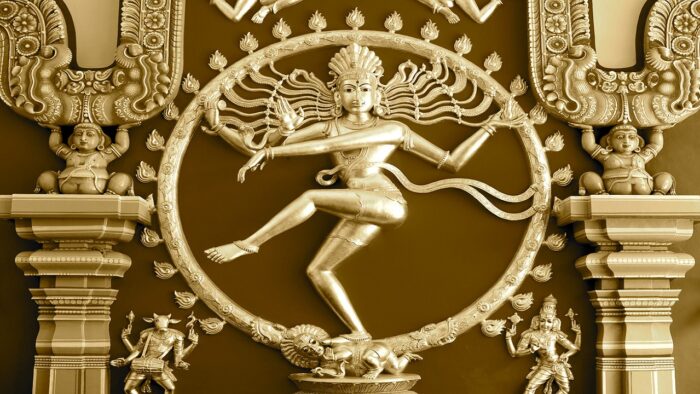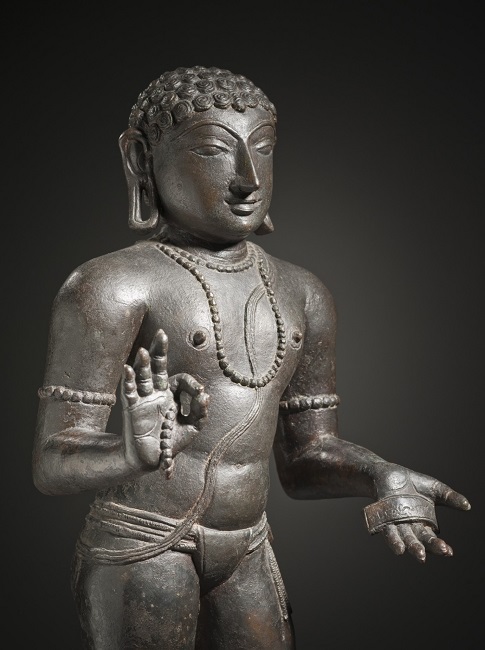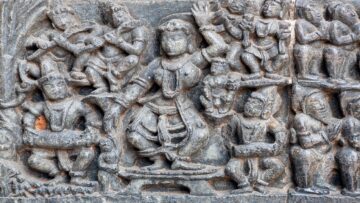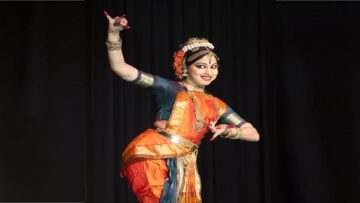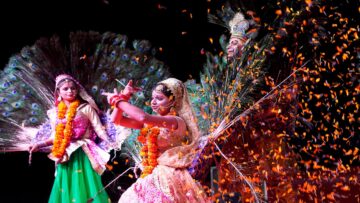We live in happy times to see a huge revival in our cultural studies in India. Study of ancient Tamil literature greatly helps in understanding the long association between Tamil and Sanskrit, which is not well understood in the present times by the general public, allowing politicians to set the narrative. Deep study only corroborates the 20th century Tamil poet Subramania Bharati’s words that Mother India speaks in many languages but her thought is one.
Introduction
The sacred Saiva poetry in Tamil tradition is known as Tirumurai, consisting of twelve books and is sung with instrumental accompaniment. The Tiruvachagam and Tirukkovaiyar of Manikkavachagar form the Eighth Tirumurai. While the earlier Thevaram hymns were chiefly poetic, expressing the exuberance of love for Lord Siva with Puranic references, in Manikkavachagar’s poetry we find philosophical terms being used to describe the significance of godhead and the profundity of Siva’s powers.
The earliest literary work available to us describing the life of Māņikkavācakar or Maņivācakar, is Vembatturar’s Tiruvilayadal Puranam, which has been placed in the 13th century CE by its editor Dr. U.V. Swaminathan. Vadhavurar Puranam is another important work about the life of Manikkavachagar whose author and date are unfortunately not known.
(Figure 1: Credit: Wikimedia Commons – Māņikkavācakar)
Manikkavachagar was born in a village called Vadhavur, to the south-east of Madurai in an accomplished Vedic Brahmin community known as Amattiya Brahmins, from which the King of Madurai was known to appoint ministers regularly. Hence he was referred to as Vadhavurar in his early life. By the time he was about seventeen years of age he was appointed as a senior official by the Pandya king Arimardhanan with the title of ‘Tennavan Brahmaroyan’ and invested with great authority.
The Arthasastra speaks of the qualities required in a minister (Amatyasampat 6.1.7):
“Native, born of high family, influential, well trained in arts, possessed of foresight, wise, of strong memory, bold, eloquent, skillful, intelligent, possessed of enthusiasm, dignity and endurance, pure in character, affable, firm in loyal devotion, endowed with excellent conduct, strength, health and bravery, free from procrastination and fickle-mindedness, affectionate, and free from such qualities as excite hatred and enmity – these are the qualifications of a ministerial officer.” (Arthasastra, p 226)
The young minister carried out his responsibilities with admirable sincerity and efficiency and there was peace and prosperity in the land. But despite his deep erudition and administrative achievements, he nursed a spiritual dissatisfaction, a searing quest for higher truth, material success holding no great charm for him. He yearned to gain the wisdom of Saiva Siddhanta and the joy of reveling in devotion to Lord Siva. The restlessness in his heart only increased day by day until he quit his material world of pomp and power and went out in search of Siva Jnana Bodha. He gained the name of Manikkavachagar from his Saiva Guru, as the verses he uttered were such gems.
Date of Manikkavachagar
Regarding the date in which Manikkavachagar lived, there are mainly two views. Some writers such as B. Natarajan hold that he lived in the 4th century CE, before the time of the Muvar. The reasons cited are that Tiruvachagam is recited and not sung in Paņ, as it may have preceded Tevaram music, that it establishes the tenets of Saivism firmly, helping the composition of Tevaram and that Apparis taken to allude to Manikkavachagar’s life. But these references in Appar’s Tevaram are ambiguous and it cannot be said with certainty to refer to Manikkavachagar.
In contrast, many scholars such as K. M. Balasubramaniam hold that Manikkavachagar lived in the first half of the ninth century CE, well after the time of the Tevaram Muvar. The reasons given for this view are that Tiruvachagam reflects a more mature development of Saiva philosophy, that the tradition has always placed him after the Muvar as the fourth and that Sundarar in his Tiruttondar Togai has not mentioned so important a devotee as Manikkavachagar. Another important evidence is that a verse in Tirukkovaiyar under the heading of Vañcitturaittal (11.5 or verse 86) makes a reference to the Govindaraja shrine in Chidambaram temple complex, which was installed in the 8th century, in saying that Lord Vishnu was in a reclined position in order to gain view of Lord Nataraja’s hallowed foot raised in dancing. Naturally the Tevaram Muvar has made no reference to this.
“Pandyakulodaya,” a Sanskrit text edited by K.V. Sarma and published in Hoshiarpur in 1981, speaks of Varaguna Pandian II who had many conquests over neighbouring chieftains, regarded to have lived in 880 CE. Aditya Chola I is described as having defeated Varaguna Pandian along with the help of several other chieftains in a joint attack near Tiruppuragam. Vadapurana Nayaka who is described as the amatya or minister of Varaguna Pandya is considered by scholars to refer to Manikkavacagar. Although differing initially, K.A.N. Sastri has also later given the reign of Varaguna Pandian II as 862 to 880 CE. (Tiruvachagam Eighth Tirumurai Part 1, p 81)
From the 5th up to the 10th century CE, Indian philosophical schools in general developed from simple foundational principles to more formalized, well-knit tenets delineated in advanced logical framework as the debates between the schools intensified. As Indian philosophy evolved over time from basic tenets to the sophisticated terminology demonstrated in Nyaya, the tenets of all schools of thought became more structured. Saivism also developed from basic principles of Siva being the cosmic principal power sustaining the universe (as also explained in the Upanishads) as well as the Supreme Being governing all living creatures with compassion and grace, to a well-organized system explaining Pati, Pasu and Pasa, creation in terms of bindu, maya, karma and five-fold malam being the root cause of karma and regeneration.
Purvamimamsa and (Advaita) Vedanta reached a pinnacle during the period of Kumarila Bhatta and Adi Sankara in the Seventh and Eighth centuries CE. The twenty-eight Agamas were also well established towards the end of the first millenium, which are explicitly mentioned in the Tiruvachagam, while the earlier Tevarams frequently mention the Vedas. Even treatises on Sanskrit poetics and literary criticism tended to adopt more logical, structured arguments in the style of Nyaya. From the simple straightforward texts such as Kavyalankara, we find later texts such as Vyaktiviveka and Rasagangadhara display great sophistication.
As for the recitation style being more the norm than setting Manikkavachagar’s poetry in Paņ melodies, that may have been the composition style he preferred as the subject is also of a more serious nature. The verse form he preferred are Ahaval and Venba, not the Isaippa which are more suited to musical notation, known as Kalippa and Vanjippa. The Ahaval verse form has a more narrative style and venba has the style of a saying. Ahaval can range from three to hundreds of lines, almost like free verse. The Viruttam style also had great flexibility in terms of the length and number of lines to a stanza. Manikkavachagar’s poems with ten stanzas are known as “Patthu”, e.g., “Arbudap Patthu”, “Kuyil Patthu”, “Setthila Patthu” and “Adisaya Patthu” whereas the songs of Tirujnanasambandhar, Appar and Sundarar are known as “Patikams”.
The Tevaram Muvar composed songs set to music, which is Isai Tamizh, Manikkavachagar’s verse is straight from the heart. So the internal evidence of Manikkavachagar’s poetry does suggest that he lived in the early part of the ninth century. Whatever be the truth regarding his date, it pales before the power of his poetry. There is a well-known saying in Tamil by the saint Tayumanavar, that one whose heart does not melt at Manikkavachagar’s verse, will not melt for any verse on earth.
திருவாசகத்திற்குருகார்ஒருவாசகத்திற்குமுருகார்.
Tiruvachakam
This work consists of fifty-one poems of varying length and styles, with the similar theme of the devotee yearning for and celebrating the glory of the Lord and His infinite love. The poems have been arranged much after the period in which Manikkavachagar lived and it is not possible to say in what chronology they were originally composed. Tradition has it that Lord Siva Himself came down and took dictation from the saint, writing down the utterances which were like gems. The thoughts expressed frequently echo the Upanishadic and Vedic teachings, as also philosophical tenets of Saiva Siddhanta. It is not even possible to fully understand the Tiruvachagam without the knowledge of the Sanskrit Vedic references. Swami Sadbhavananada has written a commentary on the Tiruvachagam presenting Upanishad quotations at every instance the ideas are found in the work.
Concurring with the development of Saiva Siddhanta metaphysics in later centuries, Tiruvachagam mentions “triple-malam” and even “five-fold malam“; in several places, Tirukkovaiyar mentions “pasam“. Siva is referred to as Turiyam or Caturtham, as distinct from and superior to Brahma, Vishnu and Rudra. There is also mention of the doctrine of “Iruvinai Oppu” or “balanced view of good and evil” and other concepts of Saiva Siddhanta. While the earlier Nayanars do not make much mention of Agamas, Tiruvachagam states them often, indirectly showing their greater importance and popularity in its time. While the Thevaram hymns hardly speak about the jivatman being converted to Sivam, Tiruvachagam frequently speaks about this state of attaining moksha or oneness with Sivam.
The metre called Kattalai Kalithurai has been used by Tirunavukkarasar as well as Manikkavachagar but the latter shows a more polished rhythm and flow than the former. This again points to the later date of Manikkavacagar, as in earlier times there was greater flexibility in many metrical compositions. For example, the Sanskrit poetry of early times in Anushtup Chandas encompassed greater variations in structure than the composition of later times.
In Indian literary tradition, poets as ancient as Kalidasa and as recent as Muthuswami Dikshita are known to glide seamlessly from Puranic episodes to philosophical concepts, sometimes in the same verse. But Manikkavachagar’s poetry seems lucidly organized, more out of clarity of thought than deliberate separation. The spirit is overwhelmed with the transformations from the vulgar to the sublime. Motifs of human love are often used in his imagery to convey the yearning for divine grace, as in Bhakti literature of Meerabai or Kabir.
A brief overview of a few hymns is done below.
- Sivapuranam
The first hymn, Sivapuranam, combines philosophical description of the Supreme in His arupa or nirguna form along with the milk of kindness that He graces His devotees with. Puranam refers to the timeless, immemorial and ageless existence of Lord Siva as the primary cause and moving force of the universe, in His formless state. Sivapuranam opens with obeisance to the pancakshara mantra, “Namacchivaya.” Lord Siva became the Agamas. Ekan, Anekan, Isan, Gurumani, Desan, etc are the epithets used in profusion.
As a lowly individual creature, Manikkavachagar speaks of the various forms he undergoes in many births — the grass, the woods, worm, the beasts, the snake and the birds, the ghosts, ghouls, rakshasas and yakshas — all of these gain release only by Siva’s benevolent grace, by understanding His glory. Siva is Omkara, the Vedas call Him the Supreme. He is subtle, but expands beyond all heights, so deep that none can fathom the depth and He even filled the world sideways. The epithets are in conformity with the Vedic and Upanishad view of the Divine.
He is the Master of the five activities of creation, sustenance, termination, obscuration and release, the Panchakritya in Shaivism. He is the meaning of the Vedas, delighting the minds of seers, like the fresh milk mixed with sugar and ghee that bubbles over.
We can see the following Sanskrit words in the first few lines of the poem, giving an indication of how ancient Tamil poetry was replete with allusions and terms popular in Sanskrit literature – Namacchivaya, Nathan, Gurumani, Agamam, Ekan, Anekan, vegam, kara, Siras, Desan (Tejas), Nimala (nirmala), Maya, Devan, Omkara, etc.
- Keerthi Tiru Ahaval
In contrast, the Keerthi Tiru Ahaval is an account of the innumerable acts of grace or miracles performed by the Lord from times immemorial for the sake of his sincere devotees. There is a ring of historicity in this hymn which commemorates the association of various sacred places as narrated in Linga Purana, Siva Purana etc. From Mount Mahendra, He bestowed the Agamas and in five-faced form, explained their meanings. At the dawn of creation, He gave the four Vedas to the Rishis.
- Potri Tiru Ahaval
K.M. Balasubramaniam points out that the doctrine of illusion or Māyā explained by Sankara took the Indian philosophical debate scenario with such force that it did not escape mention by Manikkavacagar, who lived close to that period. In Potri Tiru Ahaval he mentions that in the philosophical disputes of many creeds, Māyā Vāda struck like a hurricane. The Lokayata (also called Carvaka schools) are specifically mentioned as “Ulokayata”. The three activities of the Supreme, viz. creation, sustenance and termination are mentioned as also the panchakritya of Shaivism. Sanskrit words such as “Mata Udara” (mother’s womb), dukkacagara (duhkhasagara), sitta (siddha), nattika (nastika), kampittu (kampa – trembling), mutta (mukta), nitta (nitya) and puranakarana are found. The Vedantic term “turiyam” for Brahman is mentioned.
சமயவாதிகள்தத்தம்மதங்களே
அமைவதுஆகஅரற்றிமலைந்தனர்
மிண்டியமாயாவாதம்என்னும்
சண்டமாருதம்சுழித்துஅடித்துஆர்த்து
camayavātikaļtattammatańkaļē
amaivatuākaaraṟṟimalaintaṉar
miņţiyamāyāvātameṉṉum
caņţamārutamcuḻittuaţittuārttu.
- Tiru Andap Pahuti
In the Tiru Andap Pahuti replete with intricate metaphors, we find many epithets that require familiarity with the tenets of Saivism to understand. The hymn echoes the Satarudriya hymn of the Vedas in Tamil. Siva is described as the Supreme God, the Devadevan, the One primal force of the universe. The Trimurti-s, Brahma, Vishnu and Rudra, are in fact one Supreme Being, Siva, who manifests as three in phases of creation. Manikkavachagar’s imagery from nature is often symbolic and metaphorical. In this hymn he compares the five senses to the snakes in the hills that crawl out of their caves and flee from the lightning and thunder. The distress of the soul is compared to the drought which is relieved by the shower of His grace, the thunder is compared to His mercy. The mighty trees in the way of the flood of grace are likened to our deeds, good and bad, which are washed away, leading to moksha.
In the first few lines, the Lord is described as so vast that the galactic expanse is like an atom in comparison. The term used is “like a speck of dust that is floating in the sunbeam”. This is a specific allusion to the saying current in darshana tradition, especially Nyaya, to establish the existence of the atom as being one sixth that of a speck of dust visible in the sunbeam.
जालसूर्यमरीचिस्थंयत्सूक्ष्मंदृश्यतेरजः।
तस्यषष्ठस्तुयोभागःपरमाणुःसउच्यते॥(Nyayapradeepah, p 32)
Two paramanus are said to combine to form a dvyanuka and three such dvyanukas combine to form a tryanuka, which is the smallest visible structure alluded to here.
There is also a reference to the Lord seeming as clear as a nelli (amla) fruit in the palm of one’s hand – well-understood in the past, present and future. This is a clear allusion to the statement करामलकवत्विश्वंभूतभव्यभवत्प्रभुः that is found in several Sanskrit texts, e.g., Srimad Bhagavatam (2nd Skandha, first section). It was because he was endowed with such perspicuity that the disciple of Sri AdiSankara, Hastamalaka, derived his name.
- Koil Moottha Tirupatikam
Siva is described in the masculine gender, as Sakti in the feminine gender, as the combination of the two and even in the neuter gender as a force. Hence the Puranic references are only to understand which aspect one is focusing on at the time. In Koil Mootha Tirupatikam, the opening lines speak of Sakti as located within Siva and Siva as located within Sakti. When they are both located in his (the ardent devotee’s) midst, how can they not grace him, he asks!
உடையாள்உன்தன்நடுவுஇருக்கும்உடையாள்நடுவுள்நீஇருத்தி
அடியேன்நடுவுள்இருவீரும்இருப்பதானால்அடியேன்உன்
uţaiyāļuṉtaṉnaţuvuirukkumuţaiyāļnaţuvuļnīirutti
aţiyēṉnaţuvuļiruvīrumiruppatāṉālaţiyēṉuṉ
(Figure 2: Credit: Istock – Thillai Chaidambaram)
This poem is said to speak of Manikkavachagar’s gain of grace in Chidambaram, with a reference to Ponnambalam in almost all the stanzas. It alludes to anadisatkaryavada or the doctrine of pre-existence of all causal entities that has no specific beginning, well known in Sānkhya philosophy which explains that all entities that are apparently products of some cause, such as a pot from clay, are actually already existent and only come into manifestation by what we perceive as the causal effort. A pot already pre-exists in clay; clay pre-exists in its raw materials and this series of cause-effect relations goes back to the original prakrti or primordial cause of the universe. No new entity is ever created afresh out of nothing: the effect would have to be already present in the causes.
In the pre-cosmic stage when Sivan had not commenced His five-fold operation called Panchakrityam, He had His Sakti or Energy within Himself. This is what is meant by the words: “Thy Mistress dwells in Thy own midst.”
“After the commencement of the cosmic creation by the Sakti or Energy of God, she as the dynamic and cosmic aspect of the Lord, has Him within Herself. This is what is meant by the words: “Thou dwell’st in Thy Mistress’ midst.” (K. M. Balasubramaniam 2013: p 496)
This poem also has the line:
Uraiunarvuirantuninruunarvata or unarve!
“Thou standst as Gnosis beyond all word and thought!” (K. M. Balasubramaniam 2013: p 212)
This echoes the philosophy of Bhartrhari that speaks of Para Vak as true Consciousness beyond language; musicologists call as Anahata Nada, the pure vibration of thought that is beyond specific notes.
The above observations are intended to show the close and harmonious connection between Tamil language and thought with the Sanskrit traditions that is reflected in literature of all genres. Coming close after the period of Manikkavachagar, Abhinavaguptacharya in his commentary on the Natyasastra says that the usage of Manipravala is very popular in Dakshinapatha – South India, chiefly Tamilnadu. (Natyasastra Vol IV, p 1653)
- Tiruporchunnam
Manikkavachagar has composed several hymns in the format of folk songs popular among groups of girls or women engaged in tasks such as pounding of grain, plucking or stringing of flowers and other domestic activities that require rhythmic, coordinated effort. Many folk songs were in use while performing these tasks. Manikkavachagar composed songs with profound meaning that celebrated Lord Siva so that the common people could meditate upon Him and understand His glory while engaged in their daily tasks. We gain much information about the games, folk activities and daily tasks of the people of his time through these songs. Tiruporchunnam, TiruTellenam and TiruPoovalli are some of the folk style songs.
A few lyrics
English Translation by Tiruvachagamani K.M.Balasubramaniam
SIVAPURANAM
நமச்சிவாயவாழ்கநாதன்தாள்வாழ்க
namaccivāyavāḻka nātaṉtāļ vāḻka
“Namasivaya hail! Hail to the Foot of the Lord!”
இமைப்பொழுதும்என்நெஞ்சில்நீங்காதான்தாள்வாழ்க
imaippoḻutum eṉneñcil nīńkātāṉ tāļvāḻka
“Hail the Foot of Him Who does not part
Even for a twinkling from my heart!”
கோகழியாண்டகுருமணிதன்தாள்வாழ்க
kōkaḻiyāņţa kurumaņitaṉtāļvāḻka
“Hail the Foot of the Gem of Teacher ruling in Kokazhi!”
ஆகமம்ஆகிநின்றுஅண்ணிப்பான்தாள்வாழ்க
ākamamākiniṉṟu aņņippāṉ tāļvāḻka
“Hail the Foot of Him Who has become
The Agamas and Who does sweetly bide!”
ஏகன்அநேகன்இறைவன்அடிவாழ்க 5
ēkaṉ anēkaṉiṟaivaṉ aţivāḻka
“Hail the Foot of the One, the Not One and the Immanent Lord!”
வேகம்கெடுத்தாண்டவேந்தன்அடிவெல்க
vēkamkeţuttāņţa vēntaṉ aţivelka
“Victory to the Foot of the King Who calmed
The storm within the soul and made me His!”
பிறப்பறுக்கும்பிஞ்ஞகன்தன்பெய்கழல்கள்வெல்க
piṟappaṟukkum piññakaṉtaṉ peykaḻalkaļ velka
“Victory to the pair of jeweled Feet
Of Pingnakan Who snaps away all births!”
புறத்தார்க்குச்சேயோன்தன்பூங்கழல்கள்வெல்க
puṟattārkkuc cēyōṉtaṉ pūńkaḻalkaļ velka
“Victory to the beautiful Feet of Him
Who is distant unto those sans love!”
கரங்குவிவார்உள்மகிழும்கோன்கழல்கள்வெல்க
karańkuvivār uļmakuḻum kōṉkaḻalkaļvelka
“Victory to the anklet-Feet of the Lord
In Whom do those of joining palms rejoice!”
சிரங்குவிவார்ஓங்குவிக்கும்சீரோன்கழல்வெல்க10
cirańkuvivār ōńkuvikkum cīrōṉ kaḻalvelka
“Victory to the Feet of the glorious One
Who exalteth those who bow their heads!”
ஈசன்அடிபோற்றிஎந்தையடிபோற்றி
īcaṉ aţi pōṟṟi entai yaţi pōṟṟi
“Praise to Isan’s Foot! Praise to my Father’s Foot!”
தேசன்அடிபோற்றிசிவன்சேவடிபோற்றி
tēcaṉ aţi pōṟṟi civaṉcē vaţipōṟṟi
“Praise to the Bright One’s Foot! Praise to Sivan’s red Foot!”
நேயத்தேநின்றநிமலன் அடி போற்றி
nēyattē niṉṟa nimalaṉ aţipōṟṟi
“Praise to the Foot of the Spotless One Who standeth rooted in love!”
மாயப் பிறப்பறுக்கும் மன்னன் அடி போற்றி
māyam piṟappaṟukkum maṉṉaṉ aţipōṟṟi
“Praise to the Foot of the King Who snappeth off delusive births!”
சீரார் பெருந்துறைநம்தேவன் அடிபோற்றி 15
cīrār peruntuṟainamtēvaṉ aţipōṟṟi
“Praise to the Foot of our own Lord of glorious Perunthurai!”
ஆராத இன்பம் அருளு மலைபோற்றி
ārāta iṉpam aruļu malaipōṟṟi.
“Praise to the Mountain whence doth flow the bliss that satiates not!”
Some relevant Upanishadic references for the first ten lines:(Tiruvacagam (Tamil), Swami Sadbhavananada, p 110)
- Namacchivaayavaazhka – (the mantra Namacchivaya)
- नमःशिवायशिवतरायच।Sri Rudram८–१
- Imaipozhudumenne~njil– (That the Divine is in one’s heart always)
- ईशावास्यमिदंसर्वंयत्किञ्चित्जगत्यांजगत्।ईशावास्योपनिषत्१
- दह्रंविपापंपरमेश्मभूतंयत्पुण्डरीकंपुरमध्यसंस्थम्।महानारायणोपनिषत्१२–१६
- हृदिह्येषआत्मा।प्रश्नोपनिषत्।३–६
- योवेदनिहितंगुहायांपरमेव्योमन्।
समश्नुतेसर्वान्कामान्सः॥तैत्तिरीयोपनिषत्२–१
- EkanAnekan– (The One Lord in every creature)
- एकोदेवःसर्वभूतेषुगूढःसर्वव्यापीसर्वभूतात्मा।
कर्माध्यक्षःसर्वभूताधिवासःसाक्षीचेताकेवलोनिर्गुणश्च॥श्वेताश्वतरोपनिषत्६–११
- Vegamkedutta – (The Lord destroys the agitation)
- योगश्चित्तवृत्तिनिरोधः॥योगसूत्रम्२
- PirraparrukumPing~nagan– (the cessation of cycle of rebirth)
- त्र्यम्बकंयजामहेसुगन्धिंपुष्टिवर्धनम्।
उर्वारुकमिवबन्धनान्मृत्योर्मुक्षीयमामृतात्॥महा०उप०५६–१
- PurrattaarrkuCeyontan– (those in darkness of ignorance far from Light)
- असुर्यानामतेलोकाअन्धेनतमसावृताः।
तांस्तेप्रेत्याभिगच्छन्तियेकेचात्महनोजनाः॥ईशा०उप० –३
- Karan kuvivar, cirankuvivar – (those who seek easily reach the Lord)
- नायमात्माप्रवचनेनलभ्योनमेधयानबहुनाश्रुतेन।
यमेवैषवृणुतेतेनलभ्यस्तस्यैषआत्माविवृणुतेतनूंस्वाम्॥कठ०उप०२–२३
Tiruporchunnam
முத்துநல்தாமம்பூமாலைதூக்கி
முளைக்குடம்தூபம்நல்தீபம்வைம்மின்
muttunaltāmampumālaitūkki
muļaikuţamtūpamnaltīpamvaimmiṉ
1.”Suspend wreaths of pearls and flower garlands.
Place the sprout-pots, incense and the lamps.”
சத்தியும்சோமியும்பார்மகளும்
நாமகளோடுபல்ஆண்டுஇசைமின்
cattiyumcomiyumpārmakaļum
nāmakaļōţupalāņţuicaimiṉ
“O ye Sakti, Somi, Maid of Earth,
Sing the songs of hail with Saraswathi!”
சித்தியும்கெளரியுமபார்ப்பதியும்
கங்கையும்வந்துகவுரிகொண்மின்
cittiyumkauriyumpārppatiyum
kańkaiyumvantukavurikoņmiṉ
“O ye Sithi, Gouri, Parpathi,
And Gangai, come and wave the fan of fir!”
அத்தன்ஐயாறன்அம்மானைப்பாடி
ஆடப்பொற்சுண்ணம்இடித்தும்நாமே! 1
attaṉaiyāṟaṉammāṉaippāţi
āţapoṟcuņņamiţittumnāmē ! 1
“Praise the Sire, the King of Ayyaru!
To bathe Him let’s pound perfumed dust of gold!”
These are the names of the young ladies pounding the turmeric with perfume and gold, but are also the names of the celestial goddesses who are preparing for the worship of the Lord. Satti is Shakti who is Rudrani; Somi is the one born before the moon from the Milk Ocean when it was churned, i.e., Lakshmi; Parmagal is Bhudevi (Lakshmi and Bhudevi are the consorts of Mahavishnu); Nanmagal is Saraswati, consort of Brahma. Sitti (Siddhi) and Gauri are epithets for Parvati. Ganga is also mentioned. It is evident that Manikkavachagar viewed the ladies preparing the golden dust as representations of the goddesses.
Tirukkovaiyar
From the Sangam period, literature that described intimate feelings or private thoughts (mainly love) was classified as “Aham” and all other themes of public life that are outward-looking, constituted “Puram.” Tirukkovaiyar is in the style of Aham poetry with the chief purpose being Bhakti to Siva. It is the description of every jiva yearning to be united with Siva Peruman. Bhakti poetry has always used the styles and allegories of love theme, Bhakti being closely associated with Srngara in music and dance. Aham poetry usually deals with two types of love, known as kalavu and karpu. Kalavu is the love of courtship and secrecy and all the anticipation, anxiety and suspense that it involves. Karpu is marital love, which is sanctified by society and considered virtuous. Both types were meant to be chaste; when kalavu matured, it transformed into karpu; this type of Srngara did not admit infidelity, deceit or misdemeanor.
சிறைவான்புனற்றில்லைச்சிற்றம்
பலத்துமென்சிந்தையுள்ளும்
உறைவானுயர்மதிற்கூடலின்
ஆய்ந்தவொண்டீந்தமிழின்
துறைவாய்நுழைந்தனையோவன்றி
யேழிசைச்சூழல்புக்கோ
இறைவாதடவரைத்தோட்சென்கொ
லாம்புகுந்தெய்தியதே. 20
ciṟaivāṉpuṉaṟ ṟ illaicciṟṟam,
palattumeṉcintaiyuļļum
uṟaivāṉuyarmatiṟkūţaliṉ,
āyntavoņţīntamiḻiṉ
tuṟaivāynuḻaintaṉaiyōvaṉṟi,
yēḻicaiccūḻalpukkō
iṟaivātaţavaraittōţceṉkō,
lāmpukunteytiyatē. 20
- “In Chidambaram that is so lush and prosperous, endowed with plentiful rain and watered by many canals, the Lord abides with delight equally as He does in my heart (one is a lofty abode and the other, a humble one). In Madurai He is engrossed in appreciating fine Tamizh verse as well as music of the seven notes (Is that why He does not come?) The Lord with shoulders as broad as a mountain, why does he appear emaciated now?”
In this verse the young heroine expresses her longing to a companion, a Sakhi or Thozhi. She says that the Lord abides with equanimity in hallowed Tillai, in exalted Alavay, in fine Tamizh poetry and Isai as well as in her lowly heart. Emaciation is a sign of pining, of longing for the beloved that is as yet unfulfilled. In observing that the normally broad-shouldered nayaka (hero) appears lean, she hints at the longing in His heart too.
Note: Attached below are two videos for enhanced experience:
Bibliography
Balasubramaniam, K. M.- “Tiruvachagamani” (2013) Tiruvachakam of SaintManickavachakar.Palaniappa Brothers. Chennai.
GanapathiSastri T. (2002) KautiliiyamArthasastram (Sanskrit). RashtriyaSamskritSamsthan. New Delhi.
Narayanan, Sharda &Rathnavel, Madhangi (2021) Tirumurai: Glimpses into Tamil Saiva Poetry.AmbikaAksharavali. Chennai.
Natarajan, B. (1994) Tillai and Nataraja. Mudgala Trust. Madras.
Pushpendra Kumar (2019) Natyasastraof BharatamuniVol IVwith English Translation and Notes. New Bharatiya Book Corporation. Delhi.
SundaramurthyThambiranSwamigal(Ed.)(1997,1st ed.1966) Manikkavacagar: Tiruvacagam.EttamTirumurai – 1.(Tamil). DharmapuramAdheenam.Mayiladuthurai.
SundaramurthyThambiranSwamigal(Ed.) (1997,1st ed.1966) Manikkavacagar: Tirukkovaiyar.EttamTirumurai – 2.(Tamil). DharmapuramAdheenam.Mayiladuthurai.
Swami Sadbhavananada (2011) Tiruvachagam.(Tamil) Ramakrishna Math. Tiruchirapalli.
“Nyayapradeepah” Text book for Nyaya on TarkaSangraha. (Sanskrit). Karnataka Directorate of Text Books. Bengaluru.
Feature Image Credit : istockphoto.com
Watch video presentation of the above paper here Video :
Disclaimer: The opinions expressed in this article belong to the author. Indic Today is neither responsible nor liable for the accuracy, completeness, suitability, or validity of any information in the article.

